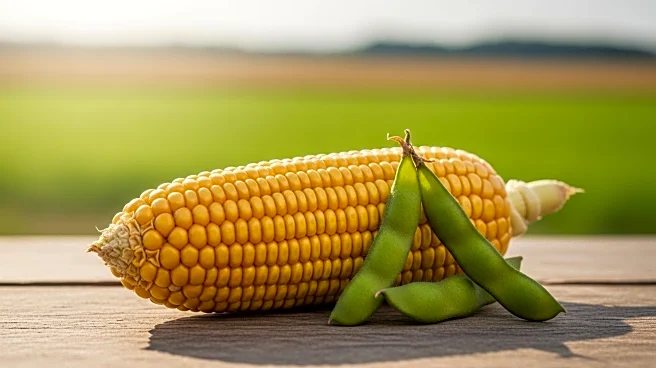What's Happening?
The U.S. Department of Agriculture (USDA) has reported mixed trends in grain and soybean futures as the harvest season begins. Soybeans for November delivery saw a slight increase, rising 1 1/4¢ to $10.35 a bushel, while soymeal gained $1.60 to $287.20 a short ton. Wheat futures for December delivery remained unchanged at $5.23 3/4 a bushel, and Kansas City futures fell 1 1/4¢ to $5.16 a bushel. The USDA noted that inspections of corn for overseas delivery increased, while wheat and bean assessments declined. The report highlighted that about 68% of U.S. corn was in good or excellent condition, a slight decrease from the previous week. The spring wheat harvest is progressing, with 85% completed, and winter wheat planting has begun, with 5% in the ground.
Why It's Important?
These developments are significant for U.S. agriculture and export markets. The increase in corn inspections suggests strong demand for U.S. corn abroad, which could benefit American farmers and exporters. However, the decline in wheat and soybean assessments may indicate challenges in these sectors, potentially affecting market prices and farmer revenues. The mixed conditions of crops, with some areas experiencing favorable weather and others facing dry conditions, could impact overall yield and quality. This situation underscores the importance of monitoring weather patterns and crop conditions closely, as they directly influence market dynamics and economic outcomes for stakeholders in the agricultural sector.
What's Next?
As the harvest season progresses, stakeholders will be watching for further updates on crop conditions and export inspections. The USDA's reports will continue to play a crucial role in shaping market expectations and decisions. Farmers and exporters may need to adjust their strategies based on evolving weather conditions and international demand. Additionally, the ongoing planting of winter wheat will be a key focus, as it sets the stage for future production and market supply.
Beyond the Headlines
The fluctuations in grain and soybean futures highlight broader issues in agricultural sustainability and economic resilience. The reliance on favorable weather conditions underscores the vulnerability of the sector to climate change and environmental shifts. Long-term strategies may need to incorporate more sustainable practices and technologies to mitigate these risks. Furthermore, the dynamics of international trade, particularly with major importers like China, will continue to influence U.S. agricultural policy and economic strategies.












